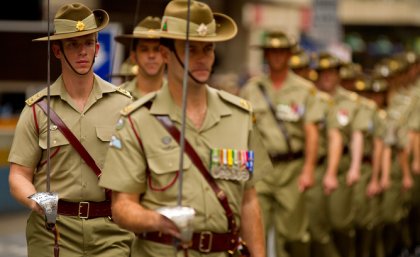
By Cate Carter
The ANZAC centenary will be full of symbols. After all, commemoration is cheaper than defence. ANZAC symbols, in particular, have an uncanny way of dismissing any doubts about defence policy and spending. However, the relationship between soldier and society is not a symbol, so it is concerning that the Alliance of Defence Service Organisations (ADSO) wants to establish a covenant known as the Australian Military Accord in this centenary year.
The proposed accord is an attempt to articulate to the public the unique nature of military service by emphasising the role played and sacrifices made by defence personnel and their families. The Australian Military Accord is based on the recently legalised British Military Covenant, but both statements have been written with the lessons of the past sitting awkwardly on the shoulders of the authors.
The British Army has a stubborn history of private administration and suspicion of government control, lest the army move closer to resembling a civil service. The Australian example acts as a “Vietnam: never again” caveat against the next generation of veterans being shunned by the public and abandoned by government.
Lessons to learn
We would do well to learn from the example of the British Military Covenant. It has been fraught with complications since it first appeared in 2000.
The covenant was originally drafted as a counter-Labour safeguard against the new emphasis on international human rights. It was written in three, short paragraphs describing the relationships between soldiers and the army, the armed forces and the government, and the army and society.
The Australian Military Accord attempts no such triangular agreement. It has been drafted without consultation with the three parties.
The British Covenant has been widely criticised in academic and military circles for various reasons. These include:
-
Its scope has broadened and become more contractual in nature, as various parties have used it for their own ends.
-
It does not articulate specific pledges, but offers ambiguous suggestions to “support”, “recognise” and “not disadvantage”.
-
The concept of “difference” in the nature of service life may be difficult to reconcile with societal norms.
-
The balance of power, when expressed through a tripartite pact, runs the risk of being destabilised by a “two against one” strategy.
-
The emphasis on “higher values and standards” creates a paradox of claiming the high moral ground while maintaining the need for a separate legal system.
-
The social organisation of the armed forces risks a professional reclassification if it is seen as an occupation rather than a vocation.
-
The concept of a multi-party agreement risks uncoupling the government from the armed forces by turning the Australian Defence Force (ADF) into a force for hire, rather than an instrument of foreign and defence policy.
-
It promotes a message of “support the troops, not the war”, which can confuse the public and result in an attitude of indifference.
An unnecessary restraint
The Australian proposal is vulnerable to similar difficulties, but also other risks of failure. A codified agreement always runs the risk of limiting a dynamic relationship to a proscriptive and politicised manifesto. That agreement would then be subject to regular review and reinterpretation according to specific incidents, leadership semantics and political preferences.
A normative approach to civil-military relations allows for the conditions of military engagement to vary and the social thinking of the nation to evolve. The proposed accord would limit this variation and evolution.
At a fundamental level, the civil-military relationship, although dynamic, contains no mutual obligation. The armed forces in a democracy are not an equal partner, but subordinate to the civil power. Arguably, the nature of service is therefore not up for negotiation.
We should also recognise that an agreement of this kind binds only two single elements of the security apparatus, which consists of much more than two groups of people.
Considerations like laws, a plausible threat, the will of the people, the concept of harm, policy, international conventions, alliances, legitimacy, sovereign authority, supply, doctrine, training, individual psychology, unit cohesion and fitness are all part of national security. A failure in any one of these elements has the potential to damage the whole apparatus. It is difficult to see how a printed (but unsigned) accord would prevent this.
The ADF exists only because the taxpayer calls for and financially underwrites it; that is the social contract. However, the taxpayer is seldom consulted on professional military matters, the military professional even less so. Whether the public clearly understands the military role or not, how far apart from the public that military stands is surely a matter for the public.
![]() This article was originally published on The Conversation. Read the original article.
This article was originally published on The Conversation. Read the original article.













